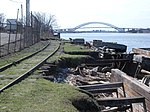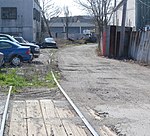Kreuzer-Pelton House
1722 establishments in the Province of New YorkHouses completed in 1722Houses on the National Register of Historic Places in Staten IslandNew York City Designated Landmarks in Staten IslandNew York City Registered Historic Place stubs ... and 5 more
Staten Island building and structure stubsStaten Island geography stubsUse American English from June 2022Use mdy dates from June 2022West New Brighton, Staten Island

The Kreuzer-Pelton House is a Dutch-influenced fieldstone house on Staten Island in New York City. Erected in 1722 as a one-room cottage, it was expanded in two stages: in 1770 and in 1836. It is designated as a New York City landmark. The house was built by Joseph Rolph. During the American Revolutionary War, Tory militia commander Cortlandt Skinner used the house as his headquarters. William IV of the United Kingdom was a guest at the house.
Excerpt from the Wikipedia article Kreuzer-Pelton House (License: CC BY-SA 3.0, Authors, Images).Kreuzer-Pelton House
Pelton Avenue, New York Staten Island
Geographical coordinates (GPS) Address Nearby Places Show on map
Geographical coordinates (GPS)
| Latitude | Longitude |
|---|---|
| N 40.643611111111 ° | E -74.111944444444 ° |
Address
Pelton Avenue 15
10310 New York, Staten Island
New York, United States
Open on Google Maps










